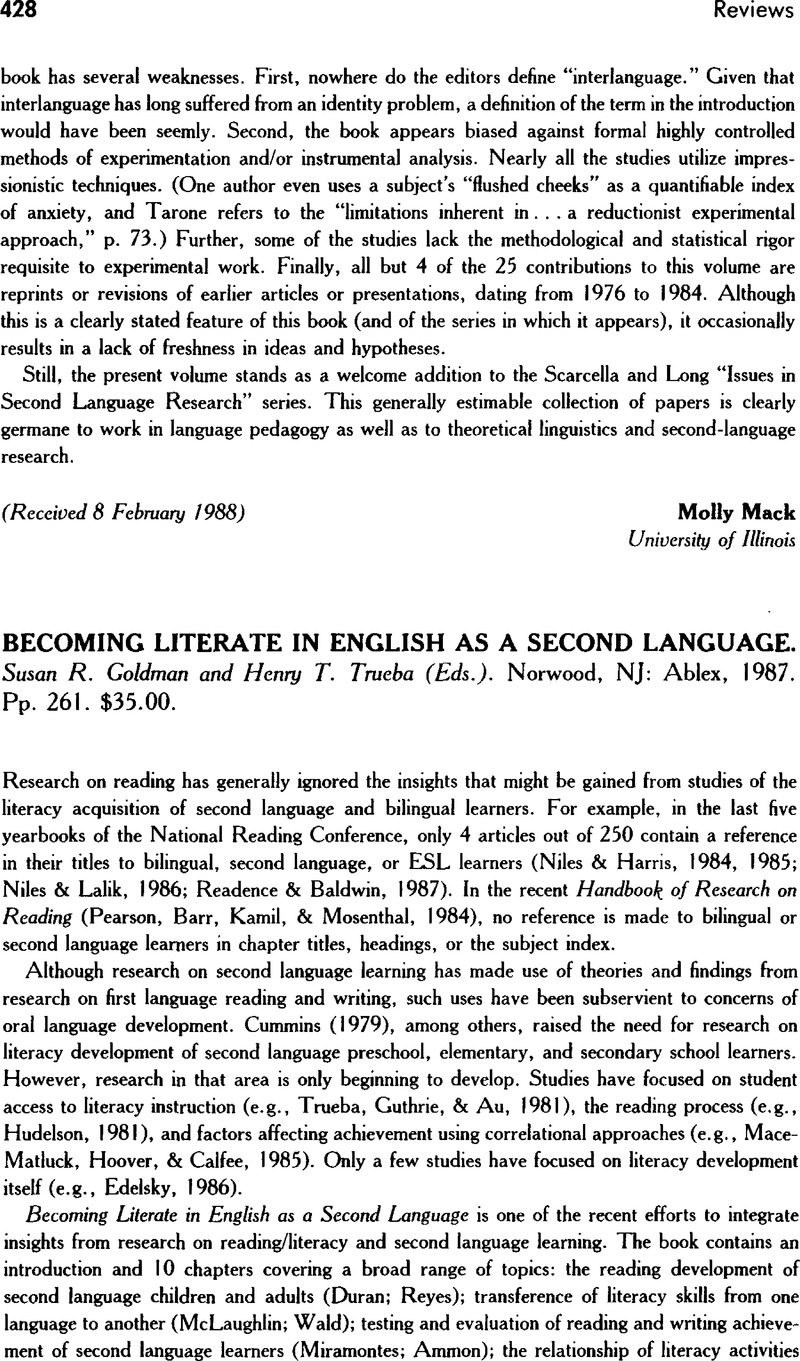No CrossRef data available.
Article contents
Becoming Literate In English As A Second Language. Susan R. Goldman and Henry T. Trueba (Eds.). Norwood, NJ: Ablex, 1987. Pp. 261. $35.00.
Published online by Cambridge University Press: 07 November 2008
Abstract
An abstract is not available for this content so a preview has been provided. Please use the Get access link above for information on how to access this content.

- Type
- Reviews
- Information
- Copyright
- Copyright © Cambridge University Press 1988
References
REFERENCES
Cummins, J. (1979). Linguistic interdependence and the educational development of bilingual children. Review of Educational Research, 49, 222–251.CrossRefGoogle Scholar
Dickerson, L. (1975). Interlanguage as a system of variable rules. TESOL Quarterly, 9, 401–407.Google Scholar
Dulay, H., & Burt, M. (1975). Natural sequences in child second language acquisition. Language Learning, 24, 37–53.CrossRefGoogle Scholar
Edelsky, C. (1986). Writing in a bilingual program. Habia una vez. Norwood, NJ: Ablex.Google Scholar
Flynn, S. (1987). A parameter-setting model of L2 acquisition. Norwell, MA: Kluwe.CrossRefGoogle Scholar
Hatch, E. (1978). Discourse analysis and second language acquisition. In Hatch, E. (Ed. ), Second Language Acquisition (pp. 401–435). Rowley, MA: Newbury House.Google Scholar
Hudelson, S. (Ed.). (1981). Learning to read in different languages (Linguistics and Literacy Series 1). Washington, DC: Center for Applied Linguistics.Google Scholar
Long, M. (1981). Input, interaction and second language acquisition. Paper presented at the New York Academy of Sciences Conference on Native and Foreign Language Acquisition.CrossRefGoogle Scholar
Mace-Matluck, B., Hoover, W., & Calfee, R. (1985). Language, literacy and instruction in bilingual settings: A K–4 longitudinal study. Austin, TX: Southwest Educational Development Lab.Google Scholar
Niles, J. A., & Harris, L. A. (Eds.). (1984). Changing perspectives on research in reading/language processing and instruction (32nd yearbook of the National Reading Conference). Rochester, NY: National Reading Conference.Google Scholar
Niles, J. A., & Harris, L. A. (Eds.). (1985). Issues in literacy: A research perspective (34th yearbook of the National Reading Conference). Rochester, NY: National Reading Conference.Google Scholar
Niles, J. A., & Lalik, R. V. (Eds.). (1986). Solving problems in literacy: Learners, teachers and researchers (35th yearbook of the National Reading Conference). Rochester, NY: National Reading Conference.Google Scholar
Ogbu, J. U. (1981). Origins of human competence: A cultural-ecological perspective. Child Development, 52, 413–429.CrossRefGoogle Scholar
Pearson, P. D., Barr, R., Kamil, M., & Mosenthal, P. (Eds.). (1984). Handbook of reading research. New York: Longman.Google Scholar
Readence, J. E., & Baldwin, R. S. (Eds.). (1987). Research in literacy: Merging perspectives (36th yearbook of the National Reading Conference). Rochester, NY: National Reading Conference.Google Scholar
Trueba, H., Guthrie, G., & Au, K. (Eds.). (1981). Culture and the bilingual classroom. Rowley, MA: Newbury House.Google Scholar


